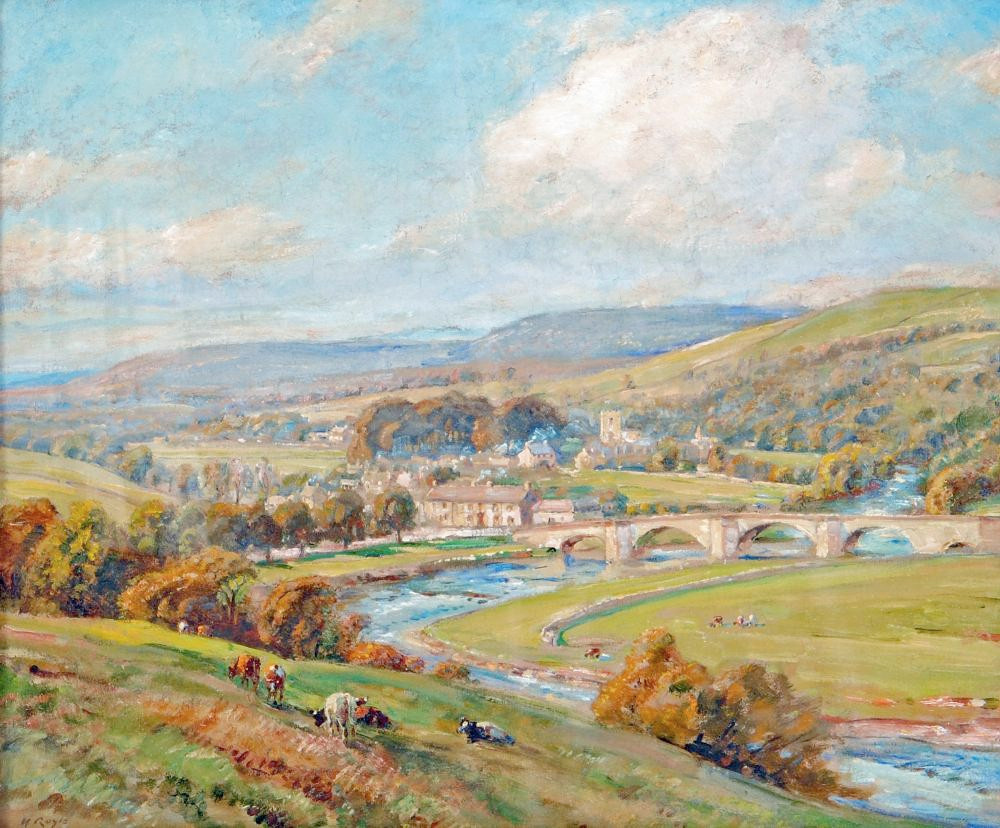search
date/time
 | Lancashire Times A Voice of the Free Press |

Andrew Liddle
Guest Writer
12:50 PM 25th July 2020
arts
Manchester Artist Who Painted The Wharfe

So this fine artist has always been one of those I look out for and have occasionally had the good fortune to come across in Manchester and Liverpool. Bradford’s Cartwright Hall have a couple of nice ones, Manor Farm, Nesfield - of the artist’s own home - and Haytime, near Nesfield.
He was born, the son of a newsagent, in Patricroft, near Manchester. Having from an early age shown an aptitude for art, he trained at the Harris Institute, Preston, the Southport School of Art and also took lessons from the much admired John Buxton Knight, at his studio in Drayton, Middlesex, and was clearly strongly influenced by Knight’s style of landscape art.
Though now largely forgotten, Royle was hugely respected in his day in artistic circles and his loving portrayals of English summer harvesting, the Wharfe in all her glory and, not least, his speciality, snow-covered fields, made him very popular with the common man. His work was highly sought after and much reproduced in the first half of the last century, arguably the last romantic age.
A member of the Manchester Academy of Fine Arts, he exhibited there annually from 1894 for almost fifty years. From 1900, he held regular exhibitions at the Royal Scottish Academy, the Glasgow Institute, the Royal Society of Painters in Oils and, extensively, at Liverpool Academy.
In adulthood, he lived firstly in Southport before, in 1918, moving across the Pennines to rent a property in the shadow of Bolton Abbey. He spent the rest of his life from 1924 onwards at the Manor House, in the hamlet of Nesfield, near Ilkley. Here he made a studio out of an old army hut on the hillside above his home. Although grand of name Manor House had no electricity and water was obtained at the village pump.
It was here that he produced the Wharfedale landscapes, particularly of scenes around Ilkley, for which he is now most remembered. It is, indeed, for his Yorkshire scenes that he is most well known so much so that he is sometimes thought of as a Yorkshire artist, a member of a Wharfedale group which included Kershaw Schofield. (Bradford-born Schofield, a fine landscape artist, was famous for throwing ‘a painting’, chucking oils on a canvas and sculpting them with a palette knife.)
Also by Andrew Liddle...
Scarborough Calling: Part Three - A Pub At The Gates Of ParadiseScarborough Calling: Part TwoScarborough Calling – Part OneSkinningrove’s Bright New Welcome For VisitorsPainting The Town With David RobinsonAs a painter of landscapes mainly in oils, his very English Impressionistic style is characterised by strong brush strokes, heavy impasto, bold vibrant colours and an eye for, shall we say, romantically hazy detail. One of my favourites is Burnsall, Autumn 1949 (above), a beautifully quiet painting, unusually in the softest shades. It seems, quite magnificently in a quiet understated way, to breathe the very quintessence of a time and place. It captures more than the landscape, stretching across to Thorpe Fell and Langerton Hill, but the delicate early Autumn air, the tones and half lights of that particularly evocative time of the year, its end and late glory. Here we have the bend in a Wharfe that is swollen and quick moving judging from the white in the blue water as it rushes through the ancient five-arched packhorse bridge restored in the 19th century. The parish church and chapel can be clearly discerned. It’s utterly beautiful.
Subsequent research has revealed holdings of his work in the Atkinson Art Gallery, Southport, Brighton and Hove Museums and Art Galleries, Cartwright Hall, Bradford, Manchester City Art Gallery, Walker Art Gallery, Liverpool, Tameside Museums & Galleries, Mercer Gallery, Harrogate, University of Leeds, and the Harris Museum, Preston.
I need to do some travelling.